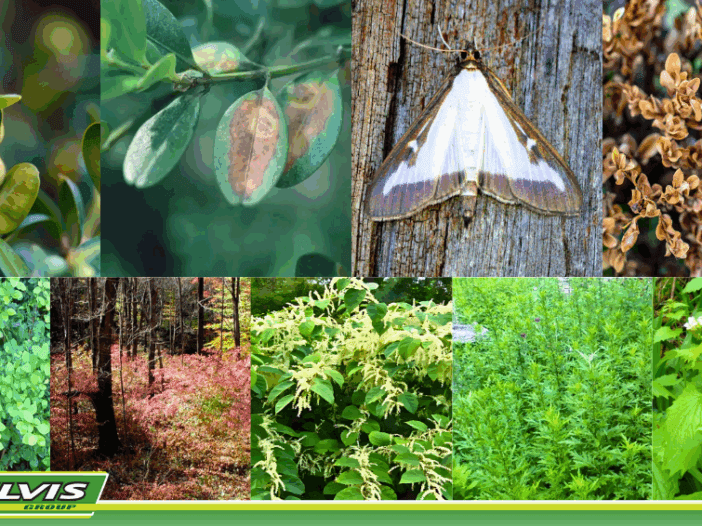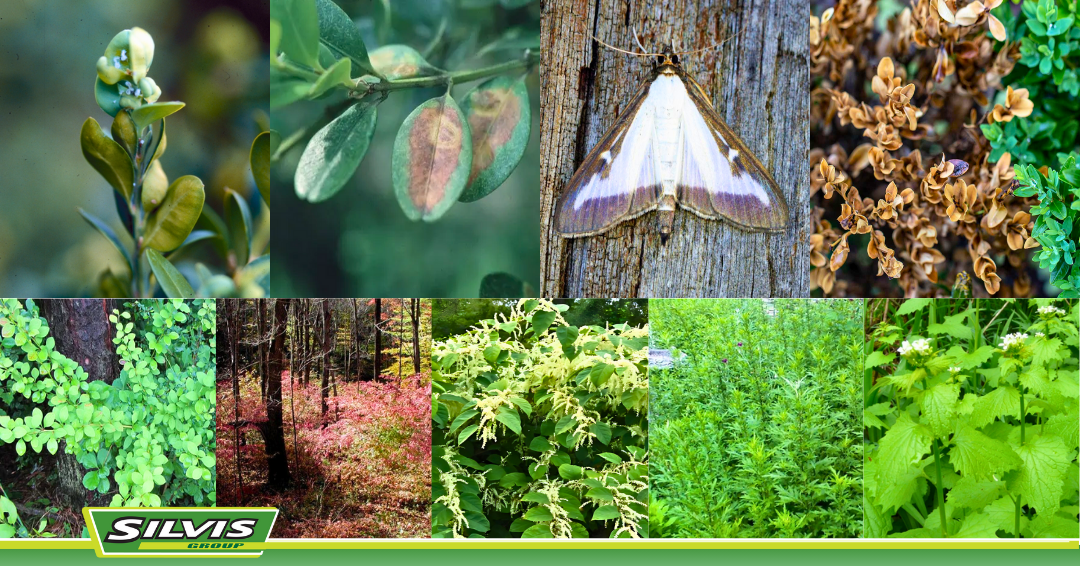

Your yard is your sanctuary—until pests, diseases, and invasive plants crash the party. These unwelcome guests don’t just ruin your weekend gardening plans—they threaten the health of your landscape, local ecosystem, and property value. At Silvis Group, we’re passionate about creating and maintaining beautiful outdoor spaces, including helping you identify and manage the common culprits that wreak havoc on Pennsylvania lawns and gardens. Let’s dig into some of our region’s most problematic pests, diseases, and invasive plants—and what you can do to keep these common yard invaders under control.
Boxwood Blunders
Boxwoods are a staple in many landscapes—compact, evergreen, and elegant. But they’re also a magnet for pests and diseases that can leave them looking ragged or even kill them outright if left unchecked.
One of the most common pests is the Boxwood Psyllid, a tiny insect that resembles a miniature cicada. These insects overwinter as eggs, then hatch in spring and start feeding on new growth. The result? Cupped or distorted leaves that ruin the shrub’s tidy appearance. While psyllids don’t usually kill the plant, heavy infestations can weaken it over time. Management involves pruning affected growth and, in severe cases, applying horticultural oils or insecticidal soaps in early spring before the insects emerge.
Worse than psyllids, the Boxwood Leafminer is the larva of a small fly that tunnels inside leaves, causing yellowing and blistering. You can often hear them chewing—it sounds like someone eating Rice Krispies. Squeeze an affected leaf; if orange goo oozes out, that’s the larvae. Left unchecked, they can defoliate the plant. Insecticides can be timed to target adults in mid to late spring, but long-term control may require planting resistant varieties or replacing infested shrubs.
The Box Tree Moth, native to Asia and first detected in the U.S. in 2021, is quickly becoming a serious threat to Pennsylvania boxwoods. Its larvae feed aggressively, often defoliating entire shrubs and leaving bare branches and webbing behind. Signs of infestation include chewed leaves, striped greenish-yellow caterpillars, and fine silky threads. Unlike other boxwood pests, this one can kill mature plants if ignored. Early detection with pheromone traps and prompt treatment with targeted insecticides are key. If you suspect it, contact a professional—quick action makes all the difference.
And let’s not forget the notorious Boxwood Blight, a fungal disease that spreads rapidly in warm, wet conditions. If you see dark spots on leaves, rapid defoliation, and black streaks on stems—especially after a rainy stretch—blight might be to blame. Once infected, boxwoods are hard to save. Remove and dispose of infected plants and consider switching to non-host species to avoid re-infection.
Unwanted Ornamentals: When Pretty Turns Problematic
Some plants were introduced into our landscapes for their looks, but have since proven to be anything but lovely in the long run. Two of the biggest offenders? Japanese Barberry and Burning Bush.
Japanese Barberry (Berberis thunbergii) is a thorny shrub with colorful foliage, popular for its low maintenance and deer resistance. But what makes it thrive in home landscapes also makes it a menace in the wild. It outcompetes native plants, creates dense thickets, and provides ideal cover for ticks—yes, those ticks. It’s especially troublesome because it alters soil chemistry, making it harder for native species to grow back even after removal.
Eradication involves digging out the plant entirely, including its root system. Herbicides like glyphosate can be used on cut stumps for stubborn infestations. And when replacing barberry, consider native alternatives like red chokeberry or fothergilla that offer similar color without the ecological damage.
Similarly, Burning Bush (Euonymus alatus) may dazzle with its fiery fall foliage, but it’s an ecological headache. It spreads aggressively by seed, forming dense stands that crowd out native plants. Like barberry, it’s now considered invasive in many parts of the Northeast.
If you’ve got one in your yard, think twice before letting it stay. Removal may take some effort, as cutting and treating the stump is the most effective approach. Replace with native stunners like serviceberry or Virginia sweetspire for fall color that won’t cost your local ecosystem.
Sneaky Spreaders: Invasive Weeds to Watch
Invasive weeds aren’t just an eyesore—they’re a serious threat to biodiversity and can be notoriously hard to control once they take root. These stealthy invaders often hitch a ride in contaminated soil, mulch, or even bird droppings.
One prime example is Japanese Knotweed, a bamboo-like plant that spreads through rhizomes and can bust through sidewalks, retaining walls, and even house foundations. It grows fast and tall, shading out everything around it. Controlling knotweed is not for the faint of heart—it often requires repeated cutting, digging, and chemical treatments over several years. If you spot it early, act quickly and decisively.

Then there’s Mugwort, which might look like a charming wildflower but spreads aggressively through underground rhizomes. It resists many herbicides and grows back from the smallest root fragments. If you’ve noticed a patch that won’t quit, no matter how much you pull, it might be mugwort. Smothering it with heavy mulch, solarizing the area with plastic, or persistent spot treatments with herbicide are your best bets.
On the other hand, Garlic Mustard is a biennial that produces thousands of seeds per plant. It’s easily hand-pulled when young (before it sets seed), but vigilance is key—seeds remain viable in the soil for years. Composting isn’t recommended, as the plant can continue to mature even after pulling.
Be the Hero Your Yard Deserves
If all of this sounds a bit daunting, don’t worry. You don’t have to go it alone. The most important thing you can do is stay informed and observant. Walk your property regularly, especially in spring and early summer when many pests and invasive species are at their most active. Learn to recognize the signs: leaf discoloration, unusual growth patterns, sudden dieback, or fast-spreading patches of greenery that weren’t there last year.
Here are some quick tips for successful management:
- Start small, act fast: Don’t wait for an issue to “work itself out”—most won’t.
- Focus on healthy plants: Stressed trees and shrubs are more vulnerable to pests and diseases.
- Plant smart: Choose native species and pest-resistant cultivars when possible.
- Mulch wisely: Mulch can help suppress weeds, but avoid mulch volcanoes and keep it away from plant stems.
- Partner with professionals: When in doubt, call in the experts.
At Silvis Group, we specialize in sustainable landscape solutions tailored to your unique property and goals. Whether you’re battling boxwood blight, looking to replace invasive plants, or just want a healthier yard overall, we’re here to help you restore balance—and beauty—to your outdoor space.
Take Back Your Landscape from Common Yard Invaders
Nature is powerful. But so are you, especially when you’re armed with the right knowledge and the right team. With a little vigilance and a lot of heart, you can outsmart the pests, say goodbye to problem plants, and build a landscape that supports not just your curb appeal but your entire ecosystem.
Ready to reclaim your landscape from common yard invaders? Get in touch with Silvis Group today and let’s grow something great together.
Sources:
Penn State Extension – Pest, Disease, and Weed Identification
https://extension.psu.edu/insects-pests-and-diseases/pest-disease-and-weed-identification
Penn State Extension – Boxwood Psyllid
https://extension.psu.edu/boxwood-psyllid
University of Maryland Extension – Boxwood Leafminer and Volutella Blight
https://extension.umd.edu/resource/common-boxwood-problems
Pennsylvania DCNR – Invasive Plants in PA: Japanese Barberry
https://www.dcnr.pa.gov
National Park Service – Burning Bush and Invasive Shrubs
https://www.nps.gov/articles/invasive-plants-burning-bush.htm
Penn State Extension – Landscaping with Native Plants
https://extension.psu.edu/landscaping-with-native-plants
Cornell University – Ground Ivy Management
https://turf.cals.cornell.edu/lawn-weeds/ground-ivy/


Leave a Reply